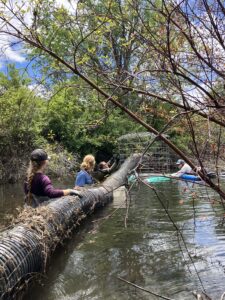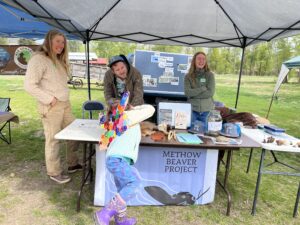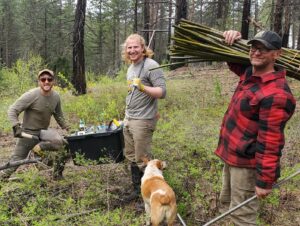Our Mission
Methow Okanogan Beaver Project promotes working with beavers as partners for restoring streams, riparian habitat, and biodiversity while reactivating wetlands, increasing natural water storage, and fostering community education and involvement to improve the health and resilience of the Methow and Okanogan watersheds.
About the Methow Okanogan Beaver Project
Methow Okanogan Beaver Project (formerly Methow Beaver Project est. 2008) is a program of the Methow Salmon Recovery Foundation, a 501(c)(3) nonprofit. Our team is based out of Twisp and Tonasket, Washington and operates across the Methow and Okanogan valleys, working to improve the function and resilience of our watersheds through five strategic pillars of action:
- Engaging with our community around topics of beavers and watershed restoration through educational events and workshops and trainings for restoration professionals and volunteer stewards
- Helping landowners to successfully live with beavers by providing resources and services to help find win-win solutions to beaver/human conflicts
- Conducting riparian restoration projects using technologies such as wood loading, beaver mimicry, and beaver relocation to increase structure and vegetation in degraded stream systems
- Relocating beavers from situations of irreconcilable human conflict to restoration sites where they can have the greatest positive ecological impact
- Helping to define the need for management policies that conserve healthy beaver populations and support greater use of beaver restoration as a landscape-scale strategy to help repair degraded river systems and rebuild watershed resilience
When we began our mission in 2008, our focus was to aid ecosystem process-based restoration by relocating "nuisance" beavers from private lands to suitable, unoccupied stream segments on public lands where their presence and behaviors would foster riparian resiliency and watershed function. In the last fifteen years, we have expanded our efforts to include watershed education and outreach, landowner-beaver coexistence services, beaver-based restoration projects, and beaver and watershed policy change, with the goal of approaching beaver-based watershed restoration as holistically as possible.
At Methow Okanogan Beaver Project, we work with partners to implement low-impact, low-cost, highly effective restoration, coexistence, and outreach strategies, that have both immediate and long term benefits to land, water quality and quantity, wildlife, and community. In addition to restoration and landowner services, we also provide research opportunities for universities and agencies, internships to students interested in environmental restoration, and guidance to similar beaver restoration projects.
As we continue our efforts, we strive to realize resilient and highly functioning watersheds that support the needs of both people and the environment through collaboration, adaptation, and ingenuity.


